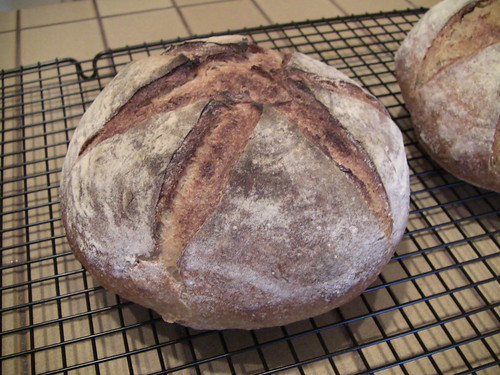
San Francisco Country Sourdough—New Sourer Variation with Wheat Germ
My wife likes her sourdough sour. And a happy wife is better than the alternative. Not that I dislike sour sourdough. Indeed, for some purposes (along side a salad, or as toast, or as an appetizer with cheese, or….), I like my sourdough sour, too.
I hadn’t changed anything up in my usual sourdough bread (which I call San Francisco Country Sourdough) for a while. I’d been meaning to try it with some toasted wheat germ added, a variation taken from the SFBI Miche formula many of us have played with. Also, the talk recently about the Larraburu Brothers bread, and means of achieving sournness, had me thinking I should go for the sour.
So I followed my usual formula, but I added 2% toasted wheat germ (18 grams) and an additional 20 grams of water. To encourage sourness, I let my liquid levain ripen longer than usual (14 hours), retarded the loaf for 16 hours after a three-hour primary ferment, and baked the loaves four and a half hours after the dough came out of the fridge (90 minute warm up, 60 minutes between pre-shaping and shaping, and a two hour proof).
The bread is nicely sour. The crust is crispy as usual. The crumb is moist and toothsome but not tough. The crumb is more regular (less full of irregular holes) than usual; this might be attributable to the wheat germ cutting gluten fibers. All in all, a good variation.
My sour-loving wife liked it, and noticed the extra wheaty flavor.
Here’s the formula:
San Francisco Country Sourdough—With Wheat Germ (version 12-8-12)
Yield: Two 770g Loaves; or Three Mini-Baguettes (245g each) and one 800g Loaf; or One 1000g loaf and two 270g baguettes; 0r Three 513 gram loaves; or…
Ingredients
LIQUID-LEVAIN BUILD
100 grams AP flour
24 grams Whole Wheat flour
12 grams Whole rye flour
170 grams Water, cool (60 F or so)
28 Mature culture (75% hydration)
FINAL DOUGH (67% hydration, including levain)
640 grams All-Purpose flour (83%)*
85 grams Whole wheat flour (11%)**
45 grams Whole rye flour (6%)
18 grams toasted Wheat Germ (2%)
455 grams Warm water (80 F or so) (58%)
17 grams Salt (2%)
306 Liquid levain (48%)
Directions
1. LIQUID LEVAIN: Make the final build 12 to 15 hours before the final mix, and let stand in a covered container at about 70°F
2. MIXING: Add all the ingredients to the mixing bowl, including the levain, but not the salt. Mix just until the ingredients are incorporated into a shaggy mass. Correct the hydration as necessary. Cover the bowl and let stand for an autolyse phase of 30 to 60 minutes. At the end of the autolyse, sprinkle the salt over the surface of the dough, and finish mixing 5 minutes. The dough should have a medium consistency.
3. BULK FERMENTATION WITH S&F: 3 hours. Stretch and fold the dough in the bowl twice 20-strokes at 45-minute intervals. Place dough ball in lightly oiled bowl, and stretch and fold on lightly floured board at 45 minutes. If the dough has not increased in size by 75% or so, let it go a bit longer.
4. RETARDED BULK FERMENTATION (optional): After second S&F on board, form dough into ball and then place again in lightly oiled bowl. Refrigerate 8-20 hours, depending on sourness desired and scheduling convenience.
5. DIVIDING AND SHAPING: [Note: if bulk retarded, let dough come to room temperature for 30-90 minutes before pre-shaping.] Divide the dough into pieces and pre-shape. Let sit on board for 30-45 minutes, and then shape into boules or batards or baguettes.
6. PROOFING: Approximately 1.5 to 2.5 hours at 72° F. Ready when poke test dictates. Pre-heat oven to 500 with steam apparatus in place.
7. BAKING: Slash loaves. Bake with steam, on stone. Turn oven to 450 °F after it hits 500F after loading loaves. Remove steaming apparatus after 12 minutes (10 for baguettes). Bake for 35 to 40 minutes total (for 750g loaves; less for smaller loaves). Rotate loaves for evenness as necessary. When done (205 F internal temp), leave loaves on stone with oven door ajar 10 minutes.
Glenn





Comments
Happily, you said 'sour-loving wife' and not 'sour, loving wife'.
Nice bake Glenn. That is exactly what I would have done to make my bread more sour: ripen the starter for longer. I am divided on how much retarding contributes to the sourness as, in my experience, it helps more with the colour and blistering than anything else, but I stand to be corrected.
Did you soak the wheat germ before adding?
Best,
Syd
Sour bread sweetens my sweety's already sweet disposition.
I didn't soak the germ. I just toasted it, let it cool, and added it to the flours.
Thanks for the comment, Syd.
Glenn
I doubt the amount of wheat germ you used accounts for the crumb you got. I suspect it's a combination of hydration and mixing. I would try either increasing the hydration - say to 70% - or mixing a bit longer. Also, with lower hydration doughs, I favor stretch and folds on the board rather than in the bowl. I can't provide data from a side-by-side comparison, but that's what I do.
David
I followed my usual formula and procedures, which usually results in a more open crumb. I will try higher hydration some time, though.
Glenn
You nailed the elements needed to produce sour bread, Glenn! congratulations. Beautiful looking boules. I guess the long retardation schedule lead to increased acid, causing the dough to develop quickly, which explains the fine crumb.
A lovely bread to be had!
Glenn